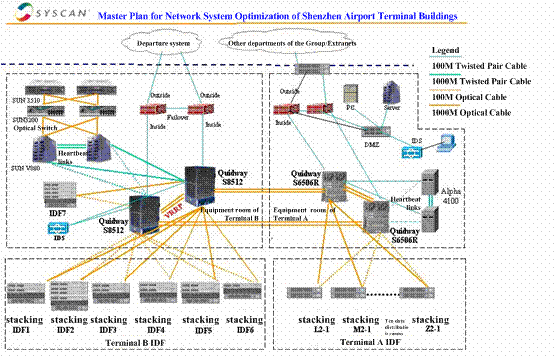China: Efficiency Starting from Arrival at the Airport——Achievements of Reconstructing the Shenzhen Bao'an International Airport Network
The stable and highly efficient network strongly supports the service platform that was built painstakingly by the Shenzhen Bao’an International Airport for airlines. The network also provides comfortable and convenient services for passengers and promotes the value of the airport network.The IATA’s Simplifying the Business Coworker award and the CAAC’s Gold Prize for Customer Satisfactory Services for four years in a roll proved the previous viewpoint.
XXX, Information Center, Shenzhen Bao’an International Airport
Customer Requirements
Put into service on October 12th, 1991, Shenzhen Bao’an Airport ranks No. 4 of all domestic airports in terms of business volume. It is the first modern international airport that realizes the combined transportation by sea, land and air in China. In 2006, the airport achieved the passenger throughput of 18.356 million person-times, cargo & mail throughput of 559,000 tons, and the take-offs and landings of aircrafts of 169,000 flights. Such achievements make the airport center of passenger and cargo air transportation in the Pearl River Delta.
To obtain more satisfaction and recognition is a essential measure for the airport to maintain enterprise competitiveness. The airport needs to continuously improve its security level and service quality and provide better services for customers. With the rocketing growth of business, the original network system can no longer keep up with the pace of service improvements. It was an inevitable task for the airport to upgrade its network system.
Ensuring Command Center’s Smooth Information Exchange and Ordered Dispatching
The production dispatching system of the airport commands and dispatches the entire airport. During the entire process from arrival to departure of the flights, the production dispatching system needs a smoothly functioning network. It can provide real-time information on flights and passengers for related departments of passenger arrival and departure, flight information display and broadcasting, refueling and maintenance, cabin cleaning, and food supply. Meanwhile, the system instructs the departments to work jointly and makes adjustments according to the feedback from the departments. As a result, the system helps the departments to cooperate with each other and provide more precise and efficient services for the landing flights of various airlines.
Improving Efficiency in Each Boarding Step
A passenger will go through such steps as check-in counter confirmation, check-in, luggage check-in, security inspection and boarding. The entire process is closely related to the passenger arrival and departure system, flight information display system, baggage check-in system, cargo, security inspection and other systems. Once the network throughput cannot meet the requirements and the traffic congestion is caused, the processing speed of the network will directly affect passengers’ interest. To enhance the network switching capability and ensure normal data transmission of various service systems is the important requirement on the reconstruction of the airport network system.
Eliminating All Potential Risks that May Affect System Stability
Once a fault occurs on the airport network, it will cause huge damage. The airport has strict requirements on the stability of the information system. It allows one system fault per year maximally. The troubleshooting time is classified into several levels. A fault should be cleared within ten minutes at most. In the past, the departure system of the airport directly connected to other service systems. The intranet was not separated from extranets. The production dispatching system was directly exposed to many potential risks. Obviously, to the way to improve the stability of the airport network environment is especially important.
H3C IToIP Expert’s Solution

According to the requirements of the airport, H3C recommends a solution that includes core layer, convergence layer, and access layer switches, intrusion detection system, and network management system. A highly efficient and security network covers Terminal A and B. It meets the performance requirements of the production dispatching system. It also provides strong support to the airport office system. It eliminates the potential security risks and lays a solid foundation for the stable operation of the airport.
10G Core and Gigabit Backbone Network Providing High Performance
According to the differences in business volume and importance, the airport deploys two high-end core routing switches at Terminal B and two high-end multi-service routing switches at Terminal A. The deployment greatly increases the network bandwidth and solve the problem of network bottleneck due to insufficient throughput. The construction of a high-performance network platform that can meet various service requirements helps the multiple application systems of the airport to run smoothly and stably. The information on various services is transferred efficiently and the airport operation efficiency is improved.
Four-level Assurance Measures for Stability
Level 1: The redundancy design is used in H3C high end core routing switch and multi-service routing switch. This can avoid the occurrence of a single-point fault.
Level 2: Terminal A and B both use the dual-core architecture. Two devices provide mutual backup, ensuring uninterrupted running of the network.
Level 3: The devices also use the VRRP mechanism, ensuring the high-speed and stable running of the network. Level 4: All the accessory devices of the network connect to the core device through double uplinks, ensuring the reliable interconnection between devices.
Separation of Production and Office Networks Eliminating Potential Security Risks
After the network reconstruction, the production network and the office network will be separated to ensure the stable running of the service network (intranet). In addition, two access policies are set for airport information query. 1. Only a few related departments are allowed to access the core server directly to query desired information. 2. External related departments are required to access the level-2 backup server to query desired information. This ensures the stable running of the main server. Meanwhile, the intrusion detection system is also installed to monitor the attacks and intrusion from the extranets. It can cut off intrusive connections in time. This system protects the system security to the maximum extent.
Key Technology: VRRP
Through the VRRP technology, router redundancy and load balance of networks can be implemented. Currently the VRRP technology is applicable to routers and in addition, has been gradually introduced to large-scale switch networks. The S8500 switch supports the graceful restart (GR) technology of the routing protocols. In the case of a single main control system is faulty, the services will not be interrupted. A single-point fault will not interrupt the services of the entire network through the VRRP redundant hot backup.
(2008-04-18)


